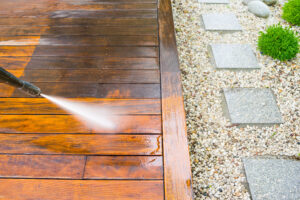When buying or building houses, our wish is for them to last forever.
However due to natural and human causes, that is practically impossible.
All we can do to prolong the lifespan of the houses is to maintain them.
Among the key ingredients of a proper maintenance is power washing your exterior every four months.
Besides restoring the visual appeal, it also increases the resale value, and reduces the need for unwarranted expensive repairs.
A good number of homeowners are tempted to conclude that
power washing is only a preserve of professionals.

Cleaning A Terrace With Hight Pressure Water
With a few simple hacks and the necessary precautions, you can also power wash your house and save yourself some money for other things.
In cases where you are short of time and craftiness to do the task, we have the professionals for that. How well you prepare greatly determines the success of this important task. Whether doing DIY or relying on professionals, this article gives a checklist for preparing your house during a power wash.
Protect Exterior Power Outlets
Exterior power cords and wires all pose a safety concern to the person doing the power washing. Exterior power cables can be entangled with that of the machine and contribute to its timely wear. You could trip, fall and sustain serious injuries when you get entangled by the exterior power cables. Worst still, you could also be electrocuted when the water stream gets in contact with the electricity. To prevent this from happening, disconnect all the cables and protect the outlets with hinged covers.
Remove All Obstacles
Obstacles such as potted plants, kids’ bicycles, grills, outdoor furniture, cans, papers, and toys should be removed from site. Apart from delaying the timeline of the task, such items are also a safety risk since you can trip over them, fall, and sustain injuries. Before commencing on the cleaning, canvass the area, identifying and removing all obstacles and other items that would be damaged by water.
Close Windows and Doors
As you go about canvassing your exterior sections, be sure to close all windows and doors tightly. The last thing you want is water getting inside your interior spaces. In the interior, water can damage furniture, walls and worse still, and cause mold, which is intricate to eradicate.
Seal all Openings
Windows and doors are not the only points for water infiltration during a power wash task. Openings such as crevices, cracks, and spaces created by worn-out weather-stripping can all allow water into the interior. During the walkover, remember to check for cracks, loose or worn-out weather stripping, and windowsills. For worn out windowsills and weather-stripping, repair or replace them accordingly and invite a professional to repair cracks. The strong water stream from the power wash machine can deteriorate such issues to significant problems that are hard and expensive to tackle.
Identify Problem Areas
Problem areas such as those with algae, mosses, and mold require special attention that may include the use of detergents amongst other cleaners. They may also require extended spraying. It is therefore advisable to canvass the entire exterior and identify them so that you can prepare adequately and effectively. Another reason to identify such areas is to avoid accidents since mold, algae and mosses are slippery.
Clear the Area
We previously mentioned that obstacles pose safety risk to the person doing the wash and can derail the turnover time. In addition, other obstacles such as cars can be damaged and this leaves you with expensive repairs to handle. Since this is not what you envisioned with hour power wash, be sure to move the vehicles out of the driveway. The clear working area provides you or a different person with an enhanced safety while streamlining the cleaning process.
Turn off Exterior Lights
Besides posing a safety risk from possible electrocution when water encounters electricity, exterior lights can also cast shadows all over the area and reduce the quality of the results. We understand the need to illuminate the working area if you are working on a rather dull day where light intensity is quite low but for your safety, never try this!
From turning off exterior lights, removing obstacles, identifying problem areas, sealing all openings, securing exterior power outlets, to inspecting for damage, there is not much when it comes to preparing the house when power washing. All these can streamline the process and make it simpler than you have ever imagined. Most importantly, your safety matters so prepare with the appropriate gear.




